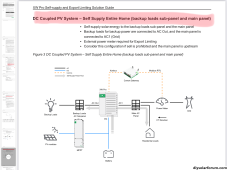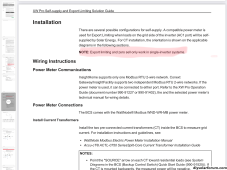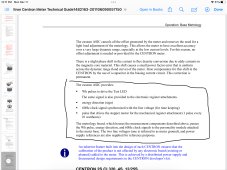Although we have all these loads, we carefully use them to moderate our power usage. We have no choice . We are fairly creative as well as stingy with our power usage.
Being in low desert there is only so much you can do other than start from scratch with a different home, real adobe construction, or start throwing away appliances with many years left in them for more efficient but likely shorter lasting ones.
The watt node is required for self supply.
Schneider brand MPPTs are required if you want "enhanced grid support" which is basically smarter selling to the grid. It allows the battery to fully charged by solar, then excess solar production can be sold to the grid, then battery can be used to support loads overnight.
I am not allowed to grid tie here by the local power company . I am looking to always draw a little, say 10 amps from the grid.
Question:
With self supply…
Do you know if I am restricted to only using Schneider MPPT’s charge controllers or could I use Schneider MPPT’s for my first 10kw pv array then add in another array of say 5 kw using a different and less expensive brand of mppt such as the eg4 mppt .
I think if I did that the Schneider would only be able to export back on ac1 based on what it could see from the Schneider mppt controlled arrays which would be whatever is available on a typical 111F day from 10 kw of pv not ideally pointed south.
But the other off brand controlled array which would be more ideally pointed could charge the batteries directly through the off brand mppt’s. I’m not sure what the implications of doing something like that are..
One thought is if I set the export at SOC level on the Schneider to 90 percent SOC would that back door the smaller non Schneider array into being available in some way for the self supply to the main panel through AC1, the watt node etc? Any guess?
4 AC units plus a well pump, a full kitchen, and water heater? Have you done an energy audit?
Absolutely.
How much of that is in the critical loads panel?
Im not certain yet. It’s complicated.
I will have only 28k of battery when they eventually get here. I need to be certain I don’t run out of battery power overnight before I have enough PV generation in the morning. It’s important to not fault the system if we are away when the grid drops out.
2 Fridges, 2freezers, a 2 ton minisplit that cools the container with the solar equipment and 1 5000 btu AC on the critical load panel is slated at present. But I’ll have to see if I have enough battery for even that then adjust my battery up as necessary.
The reason I’m not certain isn’t laziness it’s that Air conditioning and refrigeration loads vary greatly with environmental temperature.
If the house temperature rises to 105, which it will in the summer if there is no grid and whole house AC, as when the grid goes down, then all the refrigerators and freezers pull more amps as well as run more frequently. Mini-split same thing
You get more battery milage out of the batteries over night because the air that the heat is being transferred into is cooler, (outside air temperature), lowering the compressor head pressure and thereby lowering the amp draw of the compressor’s motor proportionately. Also the unit runs less often because the differential between the cooled space and the unconditioned space is less, not as much heat is transferred into it in the same time period, as during the day. With some exceptions.
I found it really difficult to calculate what the actual usage of power might be because it varies with what hours ( day or night ) your using the equipment, the weather, cloud cover, etc etc. and that varies with which month it is.
My hope is to build something with a chance of being made into what I need, then try it and make the changes as necessary. It is unlikely I will get this correct the first stab. I’ve accepted that.
You could remove some of that load with a heat pump water heater. If your worried about recovery time, keep the current electric and add the heat pump in line. That way, when you've got massive hot water needs, the big electric can supply lots of hot water, but most of the time, the heat pump can do the job much more efficiently.
Big electric water heater on the grid side so you drop it when off grid and also set to a slightly lower temperature so that it does most of the work to keep the resistance electric water up to temp.
I might go to propane for stoves and water heating temporarily or maybe heat pumps. I have a couple of propane water heaters in storage but no propane infrastructure yet and no time to work on that at present.
Eventually I would love to build a solar hot water heater since we have no lack of solar here. But that is a large and resource intensive project, at least to get it working reliably it is, and will be down the road if it ever even happens.
We get strong winds, 20mph average gusts, 45mph occasionally. No wind breaks flat land. Lucky us…These are laden with desert dust and occur for weeks at a time in the early afternoons and into the evenings. more so in the summer I think.. Calm days are often the exception and sudden gusty periods in the middle of those less prevalent calm days are another normal.
When the wind comes up you need to quickly bring the clothes in or re wash them after retrieving them from your neighbors property.?
The dryer isn’t a necessity but it’s nice.
My wife loves quickly running a load of clothes at her convenience, and I love the wife. LOL If we were off grid we wouldn’t use it.
Thanks for the help..










